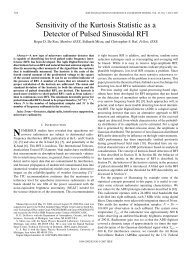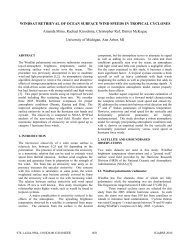Jason Microwave Radiometer performance and on-orbit - Remote ...
Jason Microwave Radiometer performance and on-orbit - Remote ...
Jason Microwave Radiometer performance and on-orbit - Remote ...
You also want an ePaper? Increase the reach of your titles
YUMPU automatically turns print PDFs into web optimized ePapers that Google loves.
<str<strong>on</strong>g>Jas<strong>on</strong></str<strong>on</strong>g> <str<strong>on</strong>g>Radiometer</str<strong>on</strong>g> Performance <str<strong>on</strong>g>and</str<strong>on</strong>g> Calibrati<strong>on</strong> 207essentially forcing the TBs to agree with the hot <str<strong>on</strong>g>and</str<strong>on</strong>g> cold references, was performed byadjusting the off-Earth sidelobe fracti<strong>on</strong>s (c-fracti<strong>on</strong>s) in the antenna pattern correcti<strong>on</strong>(APC) algorithm (Equati<strong>on</strong> 3), which is included in the Level 1b processing. Increasingthe c-fracti<strong>on</strong>s corresp<strong>on</strong>ded to an increase in the brightness temperatures at both ends of theTB range. The increase in brightness temperature was greater for the hottest TBs. Once theTBs were within the uncertainty of the theoretical hot <str<strong>on</strong>g>and</str<strong>on</strong>g> cold reference values, furtheradjustments of the c-fracti<strong>on</strong>s were performed until no significant bias was observed in theJMR–TMR PD differences. The path delays were then independently verified using theJMR–RaOb path delay differences.Satellite Yaw State TB BiasIn order for the solar panels to receive the maximum exposure to the sun during allowableranges of solar beta angles, the satellite periodically changes yaw state from a fixed mode,where the s/c yaw angle is fixed, to a sinusoidal mode, where the yaw angle changessinusoidally over time. The beta angle is the angle between the <strong>orbit</strong> plane <str<strong>on</strong>g>and</str<strong>on</strong>g> a line fromthe Earth to the Sun. The satellite is in fixed mode for about 10 days <str<strong>on</strong>g>and</str<strong>on</strong>g> sinusoidal mode forabout 30 days as the beta angle varies over its full range. The temperature variati<strong>on</strong> of theinstrument hardware is stable to about 2 K while the satellite is in either the sinusoidal or fixedyaw mode. During the transiti<strong>on</strong> from <strong>on</strong>e yaw mode to another, the thermal temperatureof the instrument hardware changes by about 13 K over a period of 12–15 hours (Figure 2)<str<strong>on</strong>g>and</str<strong>on</strong>g> temperature gradients develop between the hardware comp<strong>on</strong>ents exposed to the spaceenvir<strong>on</strong>ment <str<strong>on</strong>g>and</str<strong>on</strong>g> the internal comp<strong>on</strong>ents. This complex thermal envir<strong>on</strong>ment could not besimulated during preflight thermal/vacuum testing, leading to a residual correlati<strong>on</strong> betweenJMR–TMR brightness temperature differences <str<strong>on</strong>g>and</str<strong>on</strong>g> instrument temperature. This residualcorrelati<strong>on</strong> was removed by selecting JMR–TMR TB <str<strong>on</strong>g>and</str<strong>on</strong>g> PD differences 12 hours before<str<strong>on</strong>g>and</str<strong>on</strong>g> after a yaw transiti<strong>on</strong> <str<strong>on</strong>g>and</str<strong>on</strong>g> adjusting the JMR fr<strong>on</strong>t-end loss coefficients (K R <str<strong>on</strong>g>and</str<strong>on</strong>g> K FH ,in Equati<strong>on</strong> 1) until there were no jumps in the differences.FIGURE 2 Physical temperature of the JMR feedhorn 1 during a yaw transiti<strong>on</strong>. Noticethe temperature is stable to2Kawayfrom the transiti<strong>on</strong>.





